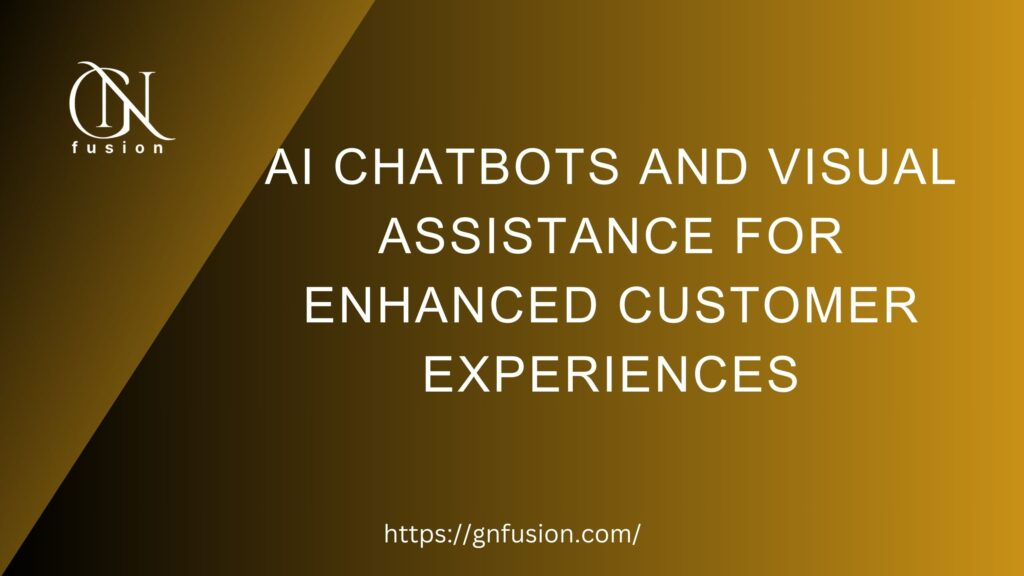Exploring the Transformative Power, Applications, and Business Impact of AI-driven Conversations and Visual Support
1. AI Chatbots: Beyond Basic Interactions
a. Natural Language Processing (NLP):
AI chatbots have evolved beyond scripted responses, thanks to advancements in natural language processing (NLP). NLP enables chatbots to understand and respond to user queries in a more contextually aware and human-like manner. The proficiency to understand nuanced language not only enhances the overall user experience but also contributes to making interactions with chatbots feel remarkably intuitive and deeply personalized. This heightened level of understanding ensures a seamless and more engaging user journey, fostering a connection that goes beyond mere transactional exchanges.
b. Multichannel Integration:
Modern AI chatbots seamlessly integrate with various communication channels, including websites, messaging apps, and social media platforms. This multichannel capability ensures that businesses can reach their customers wherever they are, providing a consistent and unified experience across different platforms.
c. Personalization and User Profiling:
AI chatbots leverage user data to create personalized interactions. By analyzing past interactions, preferences, and behaviors, these bots can offer tailored recommendations, product suggestions, or even anticipate customer needs. The ability to build user profiles contributes to a more personalized and engaging customer journey.
2. Visual Assistance: Seeing is Believing
a. Augmented Reality (AR) in Visual Assistance:
Visual assistance, often facilitated through augmented reality (AR), takes customer support to a visual dimension. In industries like e-commerce, users can virtually try on products using AR, enhancing the online shopping experience. In technical support, AR enables technicians to overlay information onto physical objects, aiding in troubleshooting and repairs.
b. Live Video Support:
Live video support allows customers to connect with support agents in real-time, sharing their physical surroundings through video. In the realm of technical support, this proves especially valuable. Agents can visually diagnose issues, expertly guide users through solutions, and even demonstrate step-by-step procedures, ensuring a comprehensive and effective troubleshooting experience. Live video support bridges the gap between remote assistance and an in-person experience.
c. Enhancing Training and Onboarding:
Visual assistance extends its benefits beyond customer support to employee training and onboarding. AR-based training programs allow employees to learn in a simulated environment, enhancing their skills and confidence. This holds significant importance, especially in industries where hands-on experience is indispensable, such as manufacturing or healthcare. Consequently, the application of visual assistance can profoundly impact training, maintenance, and overall operational efficiency. By integrating visual support into these sectors, businesses can optimize processes, enhance employee skills, and ultimately elevate the standard of operational performance.
ChatGPT Complete Guide: Learn Midjourney, ChatGPT 4 & More
ChatGPT Plugins + 25 Powerful AI Tools 10x Your Productivity and Creativity | ChatGPT, Generative AI, Prompt Engineering
3. Business Optimization Through Automation
a. Task Automation:
AI chatbots demonstrate exceptional proficiency in automating routine tasks, encompassing activities like appointment scheduling, order tracking, and efficient information retrieval. This not only streamlines processes but also significantly enhances operational efficiency. By optimizing workflows, businesses can not just reduce bottlenecks but also foster a more agile and responsive environment. This, in turn, leads to improved productivity and a streamlined operational ecosystem, ensuring that resources are utilized effectively and goals are met with greater efficiency. By handling these repetitive processes, businesses can streamline operations, reduce manual workload, and allocate human resources to more complex and strategic tasks.
b. Data-Driven Decision Making:
Both AI chatbots and visual assistance play a pivotal role in generating valuable data through user interactions. Furthermore, this data serves as a foundation for insightful analytics. Consequently, it empowers businesses to make informed decisions, enabling them to continually refine their strategies. By leveraging this wealth of information, organizations gain a competitive edge, adapting to evolving trends and staying ahead in the dynamic landscape of customer expectations.This data provides businesses with insights into customer preferences, pain points, and frequently asked questions. Through meticulous analysis of this information, companies can derive actionable insights, facilitating data-driven decisions aimed at improving products, services, and overall customer satisfaction. This strategic approach enables businesses to stay agile and responsive to evolving market demands.
4. The Future Landscape: Continuous Innovation
a. Integration with Emerging Technologies:
In the dynamic landscape of technological advancement, AI chatbots and visual assistance are poised to seamlessly integrate with emerging technologies, including machine learning, blockchain, and the Internet of Things (IoT). This integration is expected to not only further enhance their capabilities but also usher in innovative solutions to address complex challenges in an ever-evolving digital ecosystem.
b. Advanced Personalization:
Looking ahead, the future promises advanced personalization, wherein AI algorithms are set to anticipate user needs and preferences with unprecedented accuracy. This foresight marks a transformative shift, ensuring a more tailored and enriched user experience in the rapidly evolving landscape of artificial intelligence.This level of personalization will create hyper-targeted user experiences, fostering stronger connections between businesses and their customers.
c. Expanded Industry Applications:
The applications of AI chatbots and visual assistance will expand across various industries. From personalized learning in education to immersive shopping experiences in retail, these technologies will continue to redefine how businesses interact with users and how users engage with products and services.
The Transformative Potential of Generative AI: Revolutionizing Industries
Comment: Embracing the Future
In summary, AI chatbots and visual assistance transcend their current capabilities, showcasing a potential to evolve in the ever-changing technological landscape. Reflecting on their impact, it’s evident that these technologies are set for continuous growth and innovation in the dynamic realm of artificial intelligence. Businesses embracing these innovations position themselves at the forefront of a digital revolution, where enhanced customer engagement, streamlined processes, and data-driven insights converge for a more efficient and satisfying user experience. Looking ahead, the integration of AI chatbots and visual assistance is not merely a trend; it’s a strategic imperative for businesses aiming to thrive in an increasingly digital world.
If you enjoy this article or find it helpful. Please like, comment, and share this post.


